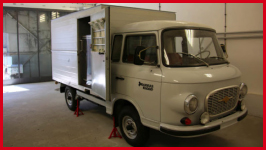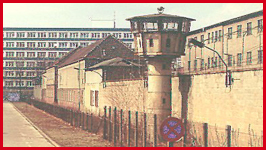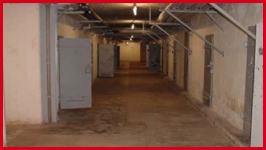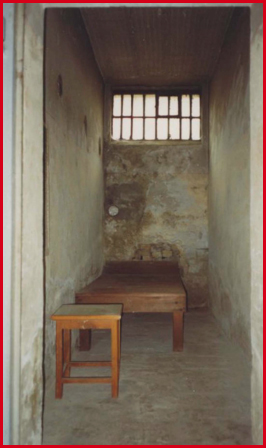 A 'Green Minna' prisoner transport van.
A 'Green Minna' prisoner transport van.
Prisoners were taken to the prison in vans disguised to appear like bread delivery vans. In this (as in so much) the Stasi followed the actions of their Soviet counterparts. In the Soviet Union since Stalin's time the KGB transported their prisoners in vans inscribed with the word 'Khleb' (bread). Prisoners were held in tiny compartments, separated so they could not see their fellows (the same applied while inside the jail, strict segregation was the norm).
 Berlin-Hohenschönhausen remand & interrogation centre. (Photo; Gedenkstätte Berlin-Hohenschönhausen)
Berlin-Hohenschönhausen remand & interrogation centre. (Photo; Gedenkstätte Berlin-Hohenschönhausen)
The prison was a former post-World War II Soviet internment camp. The Stasi took it over in the early nineteen 'fifties where it served as its principal remand and interrogation centre. As with every other aspect of the Stasi it grew and multiplied. By 1990 there were 18 centres in all controlled from the administrative headquarters in Hohenschönhausen. All of the windows in the prison were of opaque glass so the prisoners had no idea of where they were being detained. The surrounding buildings were apartments occupied by Stasi families so the ordinary citizens too had no idea of the location of the centre. It was in some respects akin to the 'nacht und fug' (semi-indefinite detention in an unknown place) practiced by the Nazis.
 The notorious 'Submarine' or 'U-Boat' cells in Hohenschönhausen. (Photo; Gedenkstätte Berlin-Hohenschönhausen)
The notorious 'Submarine' or 'U-Boat' cells in Hohenschönhausen. (Photo; Gedenkstätte Berlin-Hohenschönhausen)
Psychological pressure allied to physical deprivation was the main means used to bend prisoners to the will of the authorities. Though casual brutality by prison warders or more planned physical mistreatment were not unknown. Except for rare exercise periods (solitary) and interrogation sessions most remand prisoners were isolated in their cells twenty-four hours a day. Meals were passed in through a hatch in the cell door. Throughout their time in Hohenschönhausen they were referred to only by the number assigned to them on arrival. Association with other prisoners was forbidden to the extent that sets of 'traffic lights' were used to ensure that prisoners did not accidentally encounter fellow prisoners while being escorted to and from interrogation.
Prisoners rose at 7AM. During the day they were not permitted to lie on their beds even (as was often the case) if they had been attending interrogation for four or five hours during the night. They were often set exercises such as writing and re-writing their confessions, or accounts of their movements. No independent reading or writing matter was available. Interrogations were the only break from the appalling boredom and so a huge dependency on their interrogators was created. In the interrogation suites prisoners were made sit on a stool in the corner of the room facing their interrogator, much like a bold child.
Any infraction of the rules was punished with the utmost severity. It might be spell in the U-Boat (above) a series of dank, airless subterranean cells that were freezing in winter, foetid in summer, where the individual cells there (see below) were even smaller than the standard. For particularly recalcitrant prisoners a spell in the cooler was ordered. This was a nightmare. Two beehive shaped cells, soundproofed and light proofed, totally dark and totally without sound, the walls being of padded rubber. Incarceration in them is beyond describing.
 A cell in the U-Boat. All windows in the prison were constructed of opaque glass blocks (Photo; Gedenkstätte Berlin-Hohenschönhausen)
A cell in the U-Boat. All windows in the prison were constructed of opaque glass blocks (Photo; Gedenkstätte Berlin-Hohenschönhausen)










